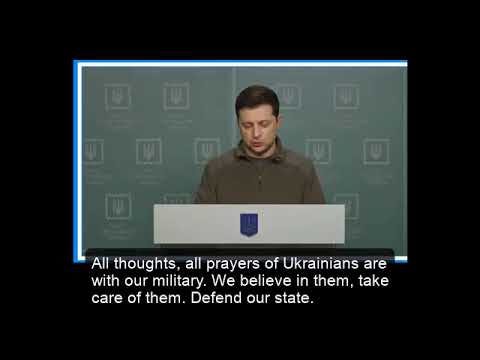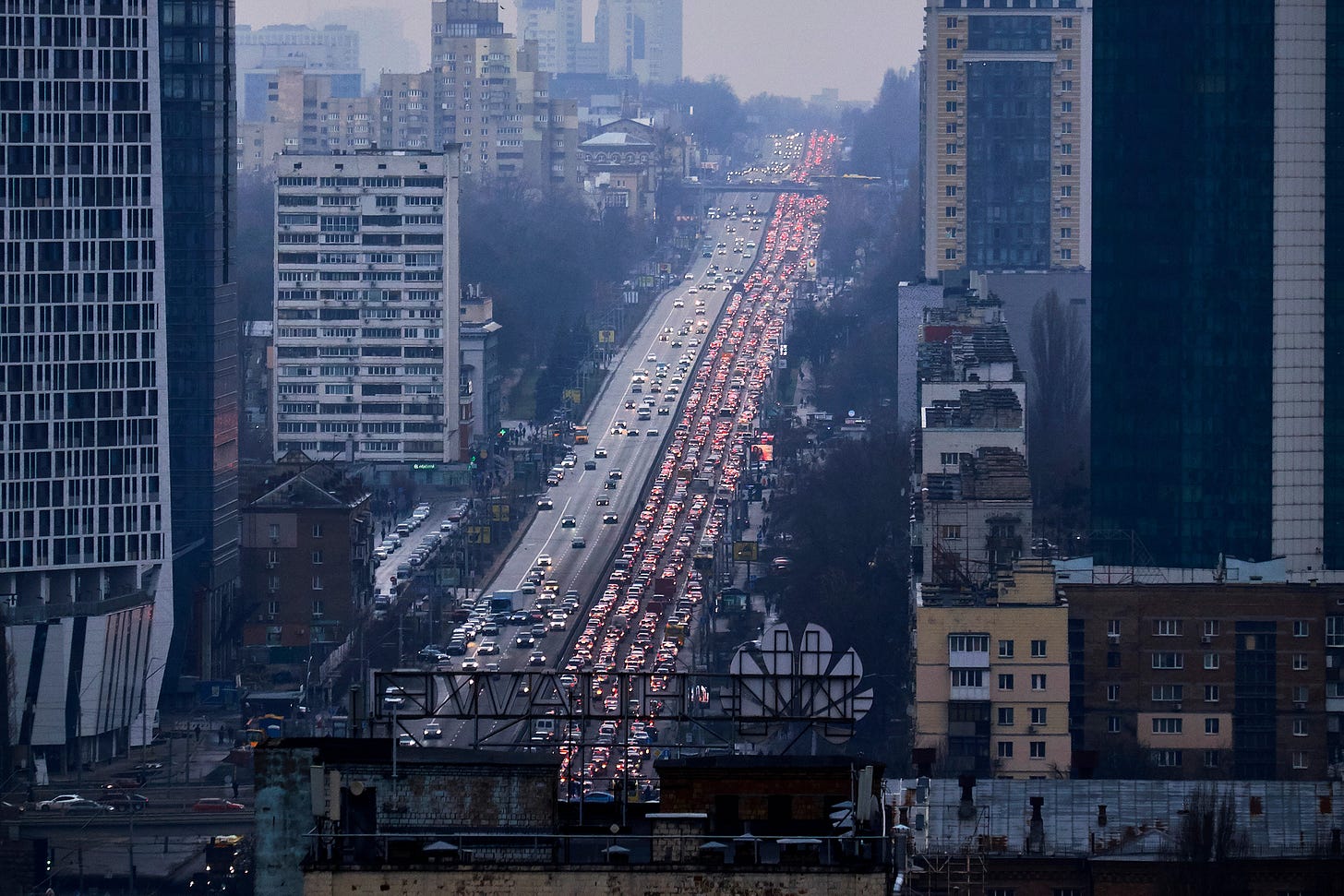February 24, 2022- Russia's full-scale invasion of Ukraine
Post, videos, commentary from Ukraine and around the world
Russia’s full-scale invasion of Ukraine 02.24.22
The days leading up to February 24, 2022 were truly frenzied.
My colleagues and I were on pins and needles, constantly checking our feeds, and sending messages to friends in Ukraine to see how they were doing, and if they had decided to leave their cities to go to farther west. Some did, some stayed.
I remember the day when the Russian forces took over Crimea in 2014. February 23-24-25 was nothing like that for me personally. Watching the full-scale invasion unfold, thinking of some friends in Ukraine, and their worried families in Italy and US, put me into a completely different mental state. Russia’s wars in Chechnya and Syria were a reminder of the destruction Russian forces are capable of, and what they do to civilians, and soldiers. I’m confident that their crimes will be brought to light, and tried at the Hague or whatever international court can be pulled together. It still doesn’t make the fear go away or that feeling of total helplessness.

As I was assembling this post, watching the videos from that evening, seeing the destruction, and listening to the comments, all the emotion of those days came back. I’m still in shock by the invasion itself and everything that has happened since. What’s worse is that there are people I know that still cannot attribute the blame and responsibility of this attrocious act on Russia, and its leadership. That’s really hard to swallow.
It was the Ukrainian people that snapped me out of my feeling of helplessness. They were there on the front, seeking shelter in the underground or wherever they could find it, and grabbing their go-bags to run away from the Russian onslaught. They got organised: thousands of volunteers helping each other and their compatriots in so many ways: carrying their grandmothers across bridges, rescuing animals, cooking on open fires, distributing clothing, singing to their children to drown out the boom of explosions. Several people I know ran to Poland to help with the displaced people of Ukraine coming over the border. There are thousands of heroic stories of what normal Ukrainians did and do to defend their homes and families.

I will never forget the conversation Olga and I had with Oleksandra Matviichuk in March 2022. As she talked about the war crimes she and her volunteer staff were documenting, the stories of families and lives ripped apart, she maintained her inner humanity and composure. I asked her how she was coping with her work, with the atrocities, and she said, “We don’t have time,” to sit and think on it. There will be time after the war to process the emotions.
This is the spirit I see in so many Ukrainians I know: the greater evil is there, and it won’t be forgotten or go unpunished but the time to act is now. That’s what each Ukrainian did in those days in February. We are reminded of the stand they took to defend themselves from the first missile that struck Kyiv, and many other cities across south, east, and north Ukraine in the video that follows with President Zelensky, and the posts you’ll be reading below.
President Zelensky addresses the nation and the Putin- Feb 23, 2022

Attacks across south, east, north Ukraine
Citizens leaving Kyiv- martial law introduced


Sky News reporting
President Zelensky and the government are here
“There is no purgatory for war criminals: they go straight to hell, Ambassador.”


President Zelensky addresses the nation Feb 26, 2022
Maria Avdeeva began documenting the war, and the crimes committed by the Russian forces as soon as February 24. She stayed in Kharkiv, her home city, and walked in between air raid sirens, she walked the streets with her camera, recording the destruction. She does this daily, and has reported from other cities in Ukraine’s east as well.

Shaun Walker, Isobel Koshiw, Pjotr Sauer, Morten Risberg, Liz Cookman and Luke Harding, Mariupol: The Ruin of a City- The Guardian
Please read the following reportage, which includes videos and pictures of what happened to the city of Mariupol.
For more than 80 days, the Russians bombarded Mariupol, determined to take the port city even if they had to raze it to the ground first.
After Russian forces finally crushed Ukrainian resistance last May, they set about putting their stamp on Mariupol, erasing evidence of the recent atrocities and of past Ukrainian history in the city.
A year on from the invasion of Ukraine, the Guardian tells the story of Mariupol – perhaps the bloodiest and most shocking chapter of Russia’s brutal war.
Invasion
Mariupol greets the new year, 2022, in a relaxed mood. When a strong gust of wind blows over the city Christmas tree, sending its vast illuminated branches crashing to the ground, a few suspicious types whisper that it could be a bad omen for the year ahead.
In the early hours of 24 February, it begins.
Around 5am, calls go out to the chiefs of police and other municipal services, announcing that military hostilities have begun and ordering them into their offices. Most of them are already awake, roused by the sound of Russian artillery.
At 11 in the morning, the mayor, Vadym Boychenko, convenes a press conference. Already, three civilians are dead and six injured, he says. The mood in the room is tense, but Boychenko assures the few journalists present that officials and key infrastructure workers are still working, and life will carry on.
“Don’t panic. We are ready to fight for Mariupol and Ukraine,” says the mayor.
He and most of his team will flee the city three days later.


Rallying the world…
President Zelensky travelled virturally to parliaments and general assemblies across the world to rally real support for Ukraine’s defence.







Nicholas Kristof, Biden Should Give Ukraine What It Needs to Win- NYT
So a year after Vladimir Putin’s all-out invasion of Ukraine, it’s time for President Biden to reassess and give Ukraine what it needs to end this war and save Ukrainian and Russian lives alike.
“We are well past the point of trying to measure this a few systems at a time,” said James Stavridis, a retired four-star admiral and supreme allied commander at NATO. “Putin is all in, and we should be as well. That means fighter aircraft, ATACMS, high-end anti-ship cruise missiles — the kitchen sink.”
More on specific hardware in a moment. But many military experts agree that while Biden has generally done well in supporting Ukraine, we should be doing even more.
“We’re modulating what we’re giving Ukraine,” said Wesley Clark, a retired four-star general and NATO supreme allied commander. “We’re bleeding out the Ukrainians. People are dying as a result.”
“If we want to end the war with a negotiated peace, we have to figure out the battlefield situation that will lead to a successful negotiation,” Clark added. “That probably requires going after Crimea in a serious way to convince Putin that he can’t win.”
It is also important to send a message — to Xi Jinping as well as Putin — that invasions do not pay. Of all the geopolitical nightmares ahead, perhaps the most horrific is a war over Taiwan — and one way to reduce that risk may be to ensure that Putin lives a nightmare today.
So this is not just about Ukraine. Viktor Yushchenko, a former president of Ukraine who was mysteriously poisoned after he challenged Russian interests, told me that Ukraine is a hostage in the larger Russian challenge to the global order. “It is disappointing that the West has failed to grasp this and to define what victory really means. It is not just ensuring that Ukraine wins, but also guaranteeing future international security.”


One year later…


Darth Putin and his team of tweeters have been trolling the Kremlin since 2014.
















